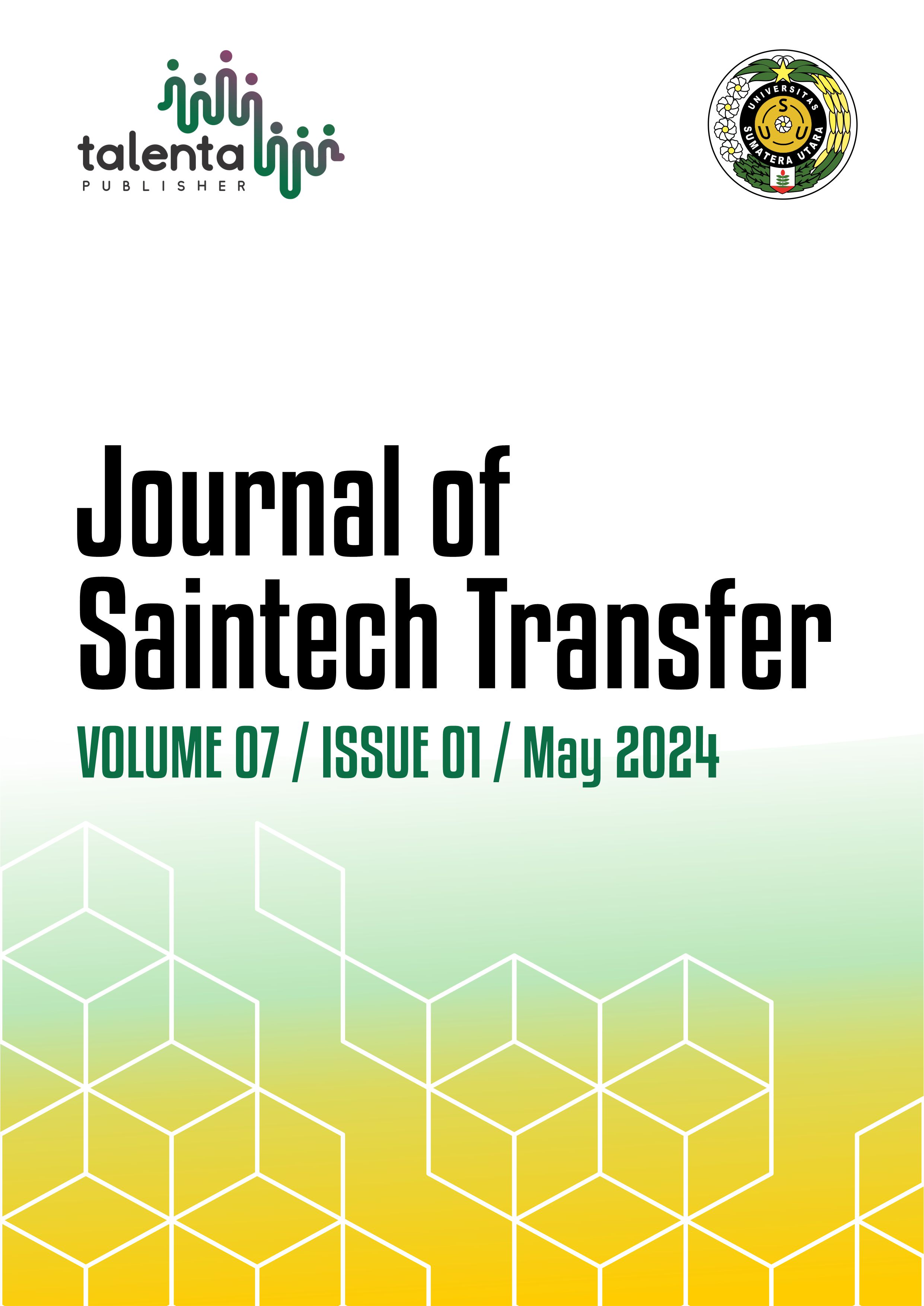Catfish and Water Spinach Cultivation Using Aquaponics as an Effort to Meet Household-Scale Food Needs in Nagori Raya Usang Village
DOI:
https://doi.org/10.32734/jst.v7i1.13380Abstract
Nagori Raya Usang Village is one of the Nagori villages in the Dolog Masagal sub-district, Simalungun Regency, North Sumatra Province. Based on the situation analysis, most village residents' livelihoods are artisans and farmers. The production of water spinach and catfish in Dolog Masagal District is still not optimal, so it is necessary to transfer science and technology in terms of cultivating fish and vegetables using an aquaponic system so that people can start businesses to meet their food needs starting from the household scale. The community service activity was carried out in September – October 2022. The implementation of this activity consists of 3 stages: field survey, outreach, and direct practice in making aquaponics with the community. The community has increased their knowledge and ability by 80% through socialization and direct practice of making aquaponics. The results of this aquaponics can be used for household-scale food consumption for vegetable and fish, or as an alternative additional income for the community.
Downloads
References
[Central Bureau of Statistics Simalungun Regency. “Kabupaten Simalungun dalam Angka 2023†[Simalungun Regency in Figures 2023]. pp: 255-342, 2023. (in Indonesian)
Director General of Agricultural Infrastructure and Facilities. “Petunjuk Teknis Rekomendasi Perlindungan Lahan Pertanian Pangan Berkelanjutanâ€[Technical Instructions Recommendations Land Protection Sustainable Food Agriculture]. Decree of the Director General of Agricultural Infrastructure and Facilities, pp. 1-30, 2022. (in Indonesian)
[Central Bureau of Statistics. “Statistik Indonesia†[Statistical Yearbook of Indoensia], pp. 92, 2023. (in Indonesian)
E.D. Sulichantini,. “Aquaponik†[Aquaponic]. Buku Ajar. Universitas Mulawarman. Samarinda. 2021. (in Indonesian)
R. A. Nugroho, L. T. Pambudi, D. Chilmawati, and A. H. C. Haditomo. “Aplikasi Teknologi Aquaponic Pada Budidaya Ikan Air Tawar Untuk Optimalisasi Kapasitas Produksi†[Application of Aquaponic Technology in Freshwater Fish Cultivation for Production Capacity Optimization]. SAINTEK Perikan. Indones. J. Fish. Sci. Technol., vol. 8, no. 1, pp. 46–51, 2012, doi: 10.14710/IJFST.8.1.46-51. (in Indonesian)
F. Rozie, I. Syarif, M. U. H. Al Rasyid, and E. Satriyanto. “Sistem Akuaponik untuk Peternakan Lele dan Tanaman Kangkung Hidroponik Berbasis IoT dan Sistem Inferensi Fuzzy†[Aquaponics System for Catfish and Kale Farms Hydroponics Based on IoT and Fuzzy Inference Systems]. J. Teknol. Inf. dan Ilmu Komput., vol. 8, no. 1, p. 157, 2021, doi: 10.25126/jtiik.0814025. (in Indonesian)
H. Hamdani, I. B. B. Suryadi, Zahidah, Y. Andriani, L. P. Dewanti, R. Sugandhy. “Manajemen Kualitas Air Dalam Budidaya Akuaponik Sistem Pasang Surut†[Water Quality Management in Tidal System Aquaponic Aquaculture]. J. Berdaya, vol. 2, no. 1, pp. 1–7, 2022, [Online]. Available: https://jurnal.unpad.ac.id/jurnalberdaya. (in Indonesian)
H. Sinaga, J. M. Nazara, I. Sinaga, S. Santikawati. “Aplikasi Teknologi Akuaponik Sederhana pada Budidaya Ikan Air Tawar untuk Optimalisasi Perencanaan Wilayah Kota Sibolga (Brassica juncea L.)†[Application of Simple Aquaponics Technology in Freshwater Fish Cultivation for Optimization of Regional Planning for Sibolga City]. Jurnal Penelitian Terapan Perikanan dan Kelautan (JPTPK), vol. 3, no. 1, pp. 33-39, 2021. (in Indonesian)
R.R. Hakim, Hariyadi. “Teknologi Akuaponik Sebagai Solusi Kemandirian Pangan Keluarga di Kelompok Kampung Wolulas Kecamatan Turen Kabupaten Malang†[Aquaponic Technology as a Solution for Family Food Independence in the Wolulas Village Group, Turen District, Malang Regency]. Amalee: Indonesian Journal of Community Research and Engagement, vol. 2, no. 1: pp. 43-52, 2021. (in Indonesian)
Asni, Rahim, and Marwayanti. “Sistem Akuaponik Dapat Meningkatkan Pertumbuhan dan Tingkat Kelangsungan Hidup Ikan Mas (Cyprinus carpio)" [Empowerment of Panti and Suci Village Communities through Oyster Mushroom Cultivation and Agribusiness Activities with a Partnership Pattern to Utilize Free Time Aquaponic System Can Increase Growth and Survival Rate of Goldfish (Cyprinus carpio)]. J. Vet., vol. 21, no. 36, pp. 136–142, 2020. doi: 10.19087/jveteriner.2020.21.1.136. (in Indonesian)
ECOLIFE Foundation. Intorduction to Village Aquaponics. ECOLIFE, 324 State Place, CA 92029. pp: 25, 2011.
H.N. Hobihah, “Produktivitas Budidaya Ikan dalam Konstruksi Sistem Akuaponik (Review)†[Aquaculture Productivity in Aquaponic System Construction (Review)]. Jurnal Akuatika Indonesia, vol. 7, no. 1, pp: 34-41, 2022. (in Indonesian)
D. Azhari, N. I. Mose, and J. R. Seke. “Efsiensi Pakan Ikan Nila (Oreochromis niloticus) yang Dibudidayakan di Sistem Akuaponik†[Feed Efficiency of Tilapia (Oreochromis niloticus) Cultured in Aquaponic Systems]. J. Ilm. TINDALUNG, vol. 4, no. 1, pp. 27–29, 2018. (in Indonesian)
R.E.S. Duhan, E. Efendi, and Suparmono. “Efektifitas Sistem Akuaponik Dalam Mereduksi Konsentrasi†[The Effectiveness of the Aquaponic System in Reducing Concentration]. e-Journal Rekayasa dan Teknol. Budid. Perair., vol. 3, no. April, pp. 2–5, 2015. (in Indonesia)
Y. Sastro, “Akuaponik: Budidaya Tanaman Terintegrasi dengan Ikan, Permasalahan Keharaan dan Strategi Mengatasinyaâ€. [Aquaponics: Integrated Plant Cultivation with Fish, Nutritional Problems and Strategies to Overcome Them]. Buletin Pertanian Perkotaan, vol. 5, no. 1, pp: 33-42, 2015. (in Indonesian)
Downloads
Published
How to Cite
Issue
Section
License
Copyright (c) 2024 Journal of Saintech Transfer

This work is licensed under a Creative Commons Attribution-ShareAlike 4.0 International License.















